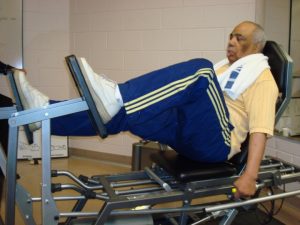Previous research supports the use of resistance training as a safe and effective exercise intervention for disabled stroke patients (Lee et al. 2010; Pak & Patten 2008). Although resistance training programs for stroke typically target improvements in maximal muscle strength, gains in muscle endurance (i.e. the ability to sustain submaximal muscle contractions) may be even more relevant to everyday activities of daily living such as carrying groceries and basic community ambulation tasks.
Our research group previously designed and implemented a unique resistance training program for stroke, involving muscle exhaustion by the 15th repetition, with additional repetitions within each 20-repetition set, made possible by a progressive lowering of weight (Ryan et al. 2011). This aggressive training approach produces substantial improvements in muscle strength, muscle size, and muscle molecular regulation in both the leg most affected by stroke and the leg less affected by stroke.
The current study (Ivey et al. 2017) was conducted to determine how this high-repetition training model impacts muscle endurance and other relevant functional outcomes. Stroke participants with residual gait deficits were randomized to 3 months (3x/ week) of either resistance training or a control intervention consisting or supervised stretching exercises. The resistance training group performed two sets of 20 repetitions on each leg for three different machine-based exercises: leg press, leg extension, and leg curl (20 repetitions x 2 sets x 2 legs x 3 exercises = 240 total repetitions per 45 minute session). The control group performed 45 minutes of supervised stretching per session, creating matched exposure to research personnel and facilities. Stroke participants in both groups were tested for muscle endurance, muscle strength, distance walked over 6 minutes, and aerobic capacity, before and after the 3-month training period. Muscle endurance testing assessed how many leg press repetitions a person could complete at 70% of maximum, at a specified cadence.
WHAT DID WE FIND?
The resistance training group improved muscle endurance by 178% and 161% in the more- and less-affected legs, respectively. At the start of the study, participants in this group completed only about 15 repetitions on the leg press machine, improving to over 40 repetitions following 3 months of resistance training. In contrast, participants in the stretching comparison group (controls) increased muscle endurance by just 12% in both legs (~2 repetition increase). Resistance trainers also demonstrated greater improvements in muscle strength, distance walked over 6 minutes, and aerobic capacity. No serious adverse events resulted from either intervention protocol.
SIGNIFICANCE AND IMPLICATIONS
Muscle endurance is an understudied aspect of function with high relevance to stroke rehabilitation. The magnitude of improvement in muscle endurance (178%) was unexpected, but suggests that this component of post-stroke function can be robustly improved across a relatively short training period, provided appropriate exercise dose-intensity and a regimen geared towards endurance gains. Many everyday tasks depend on repetitive submaximal contractions (muscle endurance). Thus, health practitioners should evaluate this component of health and implement training programs to improve it. Additional studies are needed to determine how gains in muscle endurance translate into improvements in community- and home-based function.
PUBLICATION REFERENCE
Ivey FM, Prior SJ, Hafer-Macko CE, Katzel LI, Macko RF, Ryan AS. Strength training for skeletal muscle endurance after stroke. J Stroke Cerebrovasc Dis. 26: 787-794, 2017.
If you cannot access the paper, please click here to request a copy.
KEY REFERENCES
Lee MJ, Kilbreath SL, Singh MF, Zeman B, Davis GM. Effect of progressive resistance training on muscle performance after chronic stroke. Med Sci Sports Exerc. 42: 23-34, 2010.
Pak S, Patten C. Strengthening to promote functional recovery poststroke: an evidence-based review. Top Stroke Rehabil. 15: 177-199, 2008.
Ryan AS, Ivey FM, Prior S, Li G, Hafer-Macko C. Skeletal muscle hypertrophy and muscle myostatin reduction after resistive training in stroke survivors. Stroke. 42: 416-420, 2011.
AUTHOR BIO

Frederick M. Ivey, PhD is a VA Research Health Scientist and Associate Professor, University of Maryland School of Medicine. His primary interests center around cardiovascular, metabolic and muscular adaptations to diverse exercise intervention models, as applied in stroke and other neurologic disability conditions.

